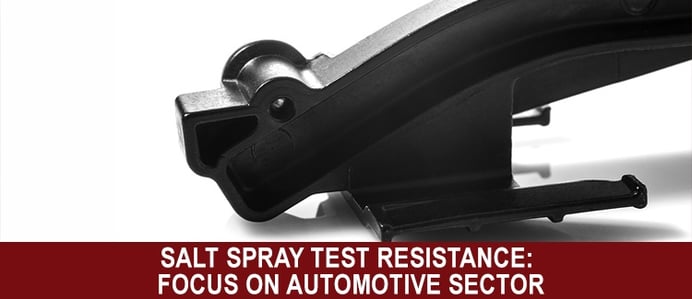As winner of numerous international awards, Bruschi Spa is known for its innovative approach in design and technology. We are glad to share our insights and experiences with the industry members.
SST – Salt Spray Test Resistance: focus on automotive sector
In this article we are going to analyze a particular corrosion test called Salt Spray Test - SST, normally used to test coatings for automotive parts, in order to test their salt or mist resistance.
Salt Spray Test (SST) is a really widespread corrosion method, applied in order to check materials and surface coatings corrosion resistance. This kind of test is an accelerated corrosion test which produces a corrosive attack to coatings to evaluate, after a pre-determined period of time, if they can be used as a protective finish. The duration of Salt Spray Test depends on coating corrosion resistance: if the coating has high corrosion resistance, the testing period is longer before the appearance of corrosion.
It can be used for different materials such as: zinc, phosphate surfaces, electroplated chromium, nickel, copper and tin and also for paint coating. Moreover Salt Spray testing is fundamental in order to evaluate product or component corrosion aimed at outdoor uses or in cold or wet environments.
Summarizing it is possible to say that Salt Spray test is used to:
- Analyze corrosive resistance of different materials and finishing
- Measure the corrosive inclination when a metal or coating is scratched
- Determine coating adhesion and corrosion creep
- Evaluate corrosion resistance in a marine environment
Products without SSL resistance would corrode under saline air influence.
Salt Spray Test application
Salt Spray test (SST) is really widespread because of its many advantages: it is quite inexpensive, multi material, quick, standardized and repeatable.
It is done using a salt spray chamber where inside are inserted parts or components to be tested. In fact Salt Spray test is used to predict which materials will resist corrosion in real conditions. The apparatus for testing is composed by a closed testing chamber, where salt water solution is sprayed due to pressurized air.
The classic Salt Spray test is atomizing salt solution into a chamber supported or suspended between 15-30° from the vertical. This solution is made of 5% of NaCI (Sodium Chloride), while the exposure zone is maintained at 35° C. The test is continuous for the entire period of test: the period can reach more than 1000h.
The consequence is an environment extremely corrosive made of dense salt water fog in this chamber where samples are exposed to it and to corrosive conditions.
Modified Salt Spray test
The majority of Salt Spray test are continuous, this means that the product under test is exposed to continuous salt fog for the entire test duration. However few product do not require such exposure: this one need a modified salt spray test. ASTM G85 is an example of test standard which contains different modified Salt Spray test.
There are different modified Salt Spray test, referred to in ASTM G85 as annexes A1 to A5. Many of these modified tests are related to particular industry sector depending on corrosion effect of environment.
- ASTM G85 Annex A1 – Acetic acid salt spray test (non-cyclic): this test is used to analyze corrosion resistance of decorative chromium plating for zinc die casting if exposed to an acetic acid salt spray climate at elevate temperature. Test samples are placed into a chamber and exposed to an indirect salt water spray solution.
- ASTM G85 Annex A2 – Acidified Salt Fog Test (cyclic): this test is normally used to test aluminum alloys corrosion.
- ASTM G85 Annex A3 – Seawater Acidified Test (cyclic): this test can be used to test corrosion of coated or uncoated metals if exposed to changing climate or acidified seawater spray followed by high humidity at an elevate temperature. Test samples are placed in the chamber system and exposed to a changing climate.
- ASTM G85 Annex A4 – SO2 Salt Spray Test (cyclic): this test can be used to test samples in a SO2 (sulfur dioxide)/salt spray/acid rain environment during their service life. These samples are placed in a chamber and exposed to 1-2 possible changing climate cycles.
- ASTM 685 Annex A5 – Dilute Electrolyte Salt Fog/Dry Test (cyclic): this test is used to test corrosion resistance for paints on steel product if exposed to changing climate of dilute electrolyte salt spray.
Zinc corrosion resistance
If compared to other materials, zinc is well known for its ability to resist to corrosive environments. However is not well known that its resistance depends on the formation of a surface barrier. Normally, when galvanized products are exposed for a normal use, for example in marine or road salt environments, zinc creates a protective layer of zinc carbonate: it resists salt attacks and ensures long-term corrosion protection.
For all the reason above mentioned, zinc is the perfect material to be used to produce automotive parts.
Please feel free to fill in the form to know more information about this topic and to be always updated on trends and innovations in Zinc Die Casting Industry, you are welcome to subscribe to our blog.



